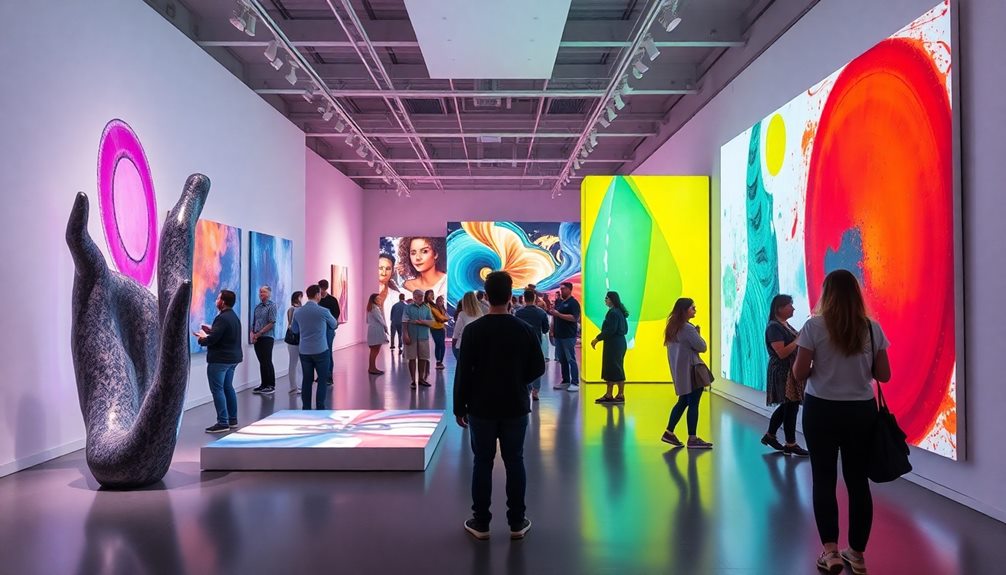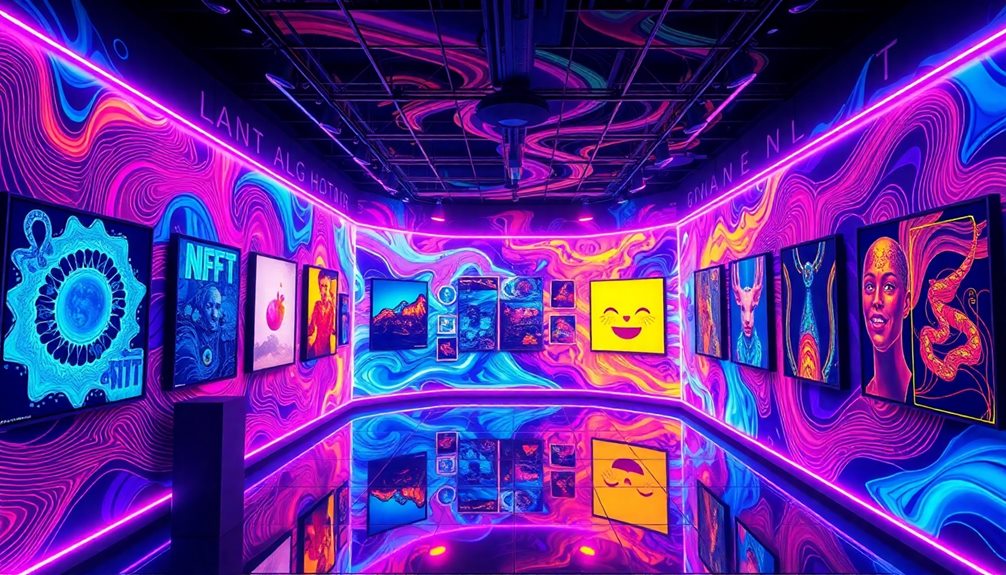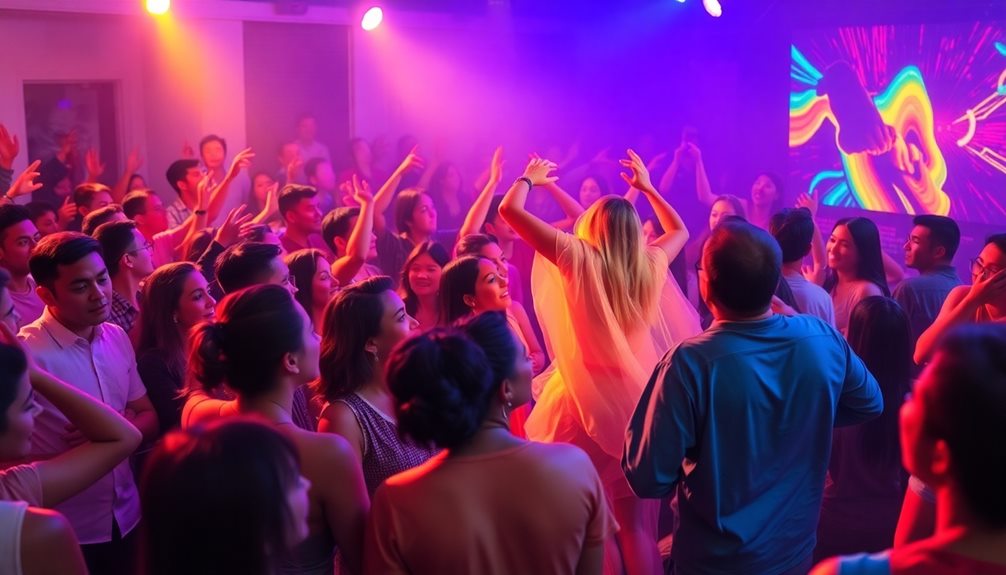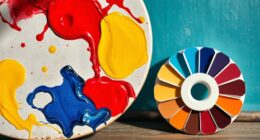Understanding contemporary art installations is about experiencing immersive environments that invite your interaction. These artworks often combine various elements like sculpture, sound, and light, creating rich sensory experiences. Emerging as a distinct genre in the 1960s, installation art challenges traditional notions by focusing on audience participation and addressing relevant social issues. You'll notice how the site-specific nature of these pieces connects deeply to their cultural and physical settings. By engaging with installation art, you not only observe but also actively participate in the dialogue it sparks. There's much more to explore within this fascinating domain of art and its evolving significance.
Key Takeaways
- Installation art creates immersive environments that engage viewers through interaction, transcending traditional art boundaries.
- It often utilizes a variety of materials and technologies, including sculpture, video, sound, and light, for multi-sensory experiences.
- Viewer participation is essential, transforming the audience's role from passive observer to active participant in the artwork.
- Installation art addresses contemporary social, political, and cultural themes, inviting personal connections and reflections on broader societal issues.
- The ephemeral nature of installations challenges traditional notions of permanence in art, prompting deeper contemplation on transience and context.
Definition of Installation Art

Installation art is a unique form of contemporary art that transforms a specific space into an immersive experience. Unlike traditional art forms that often rely on framed pieces, installation art invites you to move through and interact with the artwork itself. This genre emphasizes your experience as a viewer, making it a critical component of the piece.
Installation art can take many forms, incorporating a variety of elements like sculpture, video, sound, and light to engage multiple senses. This multi-dimensional approach creates an intense, enthralling experience that draws you in and challenges your perception of space.
Often site-specific, these installations are designed for particular locations, or they may be temporary displays that live only in the moment.
Emerging as a distinct genre in the 1960s and 1970s, installation art has roots in earlier movements such as Dada and Surrealism. Today, it continues to evolve, reflecting contemporary artistic practices and pushing the boundaries of how art can be experienced.
With installation art, you're not just a passive observer; you're an integral part of the artwork itself.
Historical Evolution

Since the 1960s and 1970s, installation art has evolved into a significant genre within contemporary art, shaped by earlier movements like Dada and Surrealism. These movements challenged conventional artistic forms, paving the way for immersive experiences. Pioneering works, such as Kurt Schwitters' Merzbau in 1933, laid the groundwork for the engaging environments we associate with installation art today.
The genre gained prominence in the 1960s, coinciding with the rise of conceptual art, which prioritized ideas over traditional aesthetics. This shift allowed artists to explore new methods of audience engagement. Following the art market crash in the early 1990s, installation art experienced a resurgence, enabling innovative approaches to viewer interaction.
Here's a snapshot of key historical milestones in installation art:
| Year | Artist | Notable Work |
|---|---|---|
| 1933 | Kurt Schwitters | Merzbau |
| 1960s | Yayoi Kusama | Infinity Mirror Rooms |
| 1960s | Claes Oldenburg | Floor Burger |
| 1990s | Damien Hirst | The Physical Impossibility of Death in the Mind of Someone Living |
| 1990s | Olafur Eliasson | The Weather Project |
These artists pushed the boundaries of what constituted installation art, shaping its evolution into an essential contemporary genre.
Key Characteristics

When stepping into an installation art piece, you're often enveloped in a world that transcends traditional boundaries of art. These installations often occupy entire rooms or gallery spaces, creating immersive environments that invite you to engage with the artwork's narrative.
You'll notice that they incorporate a wide range of materials and mediums, including sculpture, video, sound, and light, making the experience multi-sensory and enthralling.
A key characteristic of installation art is audience participation. Many installations require you to interact with the work or navigate through the space to fully grasp its message. This active engagement transforms your role from a passive observer to an integral part of the artwork itself.
Moreover, many installations are site-specific, meaning they're designed to resonate with the physical and cultural context of their location. This connection enhances your understanding and appreciation of the piece.
Finally, the ephemeral nature of some installations, which may be temporary or fragile, challenges the idea of art as a permanent object, prompting you to reflect on themes of transience and change.
Through these characteristics, installation art creates a unique and thought-provoking experience.
Conceptual Themes

In contemporary art installations, viewers often encounter a rich tapestry of conceptual themes that challenge their perceptions and provoke thought. These installations frequently address social, political, and cultural issues, immersing you in environments designed to spark dialogue and reflection.
Conceptual art thrives on this thematic depth, engaging you emotionally and intellectually as you navigate complex subjects like personal identity, memory, environmental concerns, and globalization.
The diversity of themes reflects the varied experiences and contexts of contemporary life, inviting you to reflect on your own connections to these pressing matters. By incorporating multimedia elements such as sound, light, and interactive components, installation artists enhance the conceptual themes they wish to convey.
This multifaceted approach creates a more profound experience, making you an active participant in the artwork. As you engage with installation art, you're encouraged to explore your interpretations, deepening your understanding of the themes presented.
In doing so, you may find that the artwork resonates with your own experiences and perspectives, opening up new avenues for reflection and analysis. Ultimately, conceptual themes in installation art serve to enrich your viewing experience, prompting you to think critically about the world around you.
Viewer Interaction

Engagement is at the heart of contemporary installation art, where viewer interaction transforms the experience from mere observation to active participation. When you step into an installation, you're not just a spectator; you become part of the artwork. This interaction often requires physical involvement, like walking through or traversing the space, allowing you to experience its full meaning and impact.
Here are three ways viewer interaction enhances your experience:
- Emotional Resonance: Interactive elements like sound and light can evoke strong feelings, prompting you to reflect on social or cultural themes.
- Multi-Sensory Experience: By incorporating touch, smell, and visuals, installations create a rich, immersive environment that stimulates your senses and encourages deeper contemplation.
- Participatory Art: Many artists invite you to contribute to or influence the artwork, blurring the lines between creator and audience, making you an integral part of the dialogue.
Ultimately, the success of an installation hinges on the depth of viewer interaction. When you engage actively, you transform from a passive observer into a crucial participant in the artistic conversation.
Contextual Significance

When you engage with installation art, you often encounter powerful social commentary that reflects current issues.
The cultural relevance and site-specific nature of these works transform the space around you, inviting deeper reflection on the themes presented.
This interaction not only enhances your experience but also connects you to broader societal conversations.
Social Commentary Through Art
While installation art captivates viewers with its immersive experiences, it also serves as an essential platform for social commentary, addressing urgent issues in our society. By engaging emotionally and intellectually, artists create spaces where you're prompted to confront pressing matters.
Art often reflects the complexities of our world, and installations can spotlight significant themes, including:
- Inequality: Artists challenge societal norms and provoke discussions about class, race, and gender disparities.
- Climate Change: Through visceral imagery and innovative materials, installations raise awareness of environmental crises and inspire action.
- Identity: Many works explore personal and collective identities, urging you to reflect on your place within society.
The participatory nature of installation art invites you to interact, fostering a deeper understanding of these issues.
Notable artists like Ai Weiwei and Kara Walker utilize their platforms to confront authority and human rights, making their work resonate across diverse audiences.
In this way, installation art becomes more than just a visual experience; it evolves into a dynamic dialogue about the realities we face, inspiring critical thought and encouraging change.
Cultural Relevance and Engagement
Cultural relevance in installation art transcends mere aesthetics, inviting you to explore the profound narratives embedded within each piece. This form of art often tackles pressing social, political, and cultural issues, fostering critical dialogue and reflection within contemporary society.
As you engage with installation art, you're not just a passive observer; you actively participate in the experience, confronting cultural narratives that resonate with your own experiences.
The immersive nature of installation art enhances audience engagement, allowing you to fully immerse yourself in the themes presented. Many artworks are site-specific, tailored to their locations, which deepens their cultural relevance and connection to the community around them.
This approach democratizes access to contemporary art, reaching diverse audiences and inviting everyone to grapple with complex themes.
Moreover, installation art utilizes various media and interactive elements, reflecting and responding to contemporary cultural trends. This adaptability makes installation art an essential aspect of modern artistic expression.
Site-Specific Installation Impact
Site-specific installations create a dynamic interplay between the artwork and its environment, shaping the viewer's experience in profound ways. These installations aren't just placed randomly; they engage with the unique characteristics of their surroundings, fostering a conversation between the art and the space.
Here are three key impacts of site-specific installations:
- Cultural Resonance: They often incorporate elements of local culture, history, or social issues, enhancing your understanding of the environment's context.
- Transformative Perception: By altering how you perceive a space, these installations encourage you to reconsider your relationship with the environment, making the familiar feel new.
- Community Engagement: They draw attention to specific locations, fostering community involvement and raising awareness of local narratives or challenges.
Additionally, the temporary nature of many site-specific installations challenges traditional notions of permanence in art. Instead of viewing art as a static object, you experience it as an evolving dialogue, inviting deeper reflection.
This interplay between art and context not only enriches your visit but also transforms the way you interact with your surroundings.
Installation Art in Exhibitions

Installation art captivates audiences in contemporary exhibitions, offering an immersive experience that transforms how you engage with art. Often taking center stage, installation art showcases large-scale works designed to envelop you in a sensory journey. Curators craft specific environments around these pieces, inviting you to navigate through the artwork, which encourages interaction and personal interpretation.
In many contemporary art festivals and biennials, installation art is prominently featured, highlighting its ability to push the boundaries of traditional artistic presentation. These exhibitions often reflect current social, political, and cultural themes, prompting dialogue among diverse audiences.
You'll find that installation art can be temporary or permanent, each with its own unique narrative. The integration of technology, sound, and light in installation art enhances your viewing experience, creating dynamic environments that resonate with each visitor.
As you explore these installations, you become an active participant, allowing the artwork to inspire thought and emotion. This interactive nature not only makes installation art memorable but also redefines how art can be experienced in contemporary exhibitions, encouraging a deeper connection between the viewer and the artwork.
Contemporary Techniques

In contemporary art installations, artists often use innovative materials that challenge traditional boundaries.
You'll see how interactive elements invite you to engage with the artwork, making your experience more personal and dynamic.
This blend of material and interaction not only transforms the way you perceive art but also encourages active participation in the creative process.
Innovative Material Usage
Contemporary artists are redefining the materials they use to create immersive experiences that resonate with viewers. In modern art, innovative material usage pushes the boundaries of traditional practices.
Here are three ways artists are transforming their work:
- Found Objects & Organic Materials: Artists incorporate everyday items and natural elements, such as sand and ice, to create installations that evolve over time, questioning art's permanence.
- Digital Media & Technology: The integration of virtual and augmented reality immerses you in multi-sensory experiences, forging deeper connections with the artwork.
- Mixed Media Practices: By blending painting, sculpture, and sound, artists craft cohesive narratives that engage you on various levels.
These approaches not only challenge conventional definitions of art but also invite you to explore the interplay between different mediums.
Sound installations, for instance, enhance atmospheres, while ephemeral elements provoke contemplation about change and transience.
In this way, contemporary artists are utilizing innovative materials to redefine your experience of modern art, making it more interactive and thought-provoking.
Interactive Audience Engagement
Interactive audience engagement transforms how you experience art, breaking down barriers between the artwork and the viewer. Contemporary art installations often leverage digital technologies like augmented reality (AR) and virtual reality (VR), allowing you to immerse yourself in the artwork and influence your experience. This interactivity fosters a deeper connection, making art more personal and relatable.
Many installations integrate sensory elements such as touch, sound, and movement, prompting you to physically navigate the space. Artists like Olafur Eliasson create participatory works that encourage you to interact with environmental themes, manipulating light and shadow to explore the impact of your actions.
Social media plays a significant role in this new form of engagement. Installations are designed to be shareable, pushing you to document and share your experiences online, which extends the artwork's reach and invites others to participate.
Additionally, some contemporary installations utilize feedback mechanisms, collecting your reactions and integrating them into the artwork. This dynamic approach creates an evolving art experience that reflects the community's response, emphasizing that your engagement isn't just welcomed but essential to the artwork's lifecycle.
Challenges and Interpretations

Maneuvering through the challenges of installation art can feel intimidating, especially due to its site-specific nature. You often find yourself confronting unique contexts that demand adaptive interpretations.
Claire Bishop's inquiries into installation art further complicate matters, as they highlight ongoing debates about what the form truly encompasses. Here are three key challenges you might face:
- Contextual Interpretation: Each installation's meaning can shift dramatically based on its location and environment, requiring you to engage deeply with the space.
- Interactive Elements: Your personal experience of the artwork may vary considerably from someone else's, as participation can alter emotional responses and interpretations.
- Transience and Technology: The fleeting nature of some installations raises questions about their permanence, while the incorporation of technology introduces new layers that can be both exciting and perplexing.
As installation art evolves, these challenges prompt diverse interpretations, making it essential for you to approach each piece with an open mind.
Understanding these complexities can enrich your appreciation and engagement with contemporary art installations.
Future Directions

The future of installation art is set to be incredibly dynamic and innovative, as artists embrace cutting-edge technologies and pressing societal themes. You'll witness installations that incorporate virtual and augmented reality, allowing you to step into immersive environments that challenge your perceptions. Artists are also focusing on sustainability, using their work to reflect ecological concerns and inspire action.
Expect to see more collaborative and community-based installations, fostering inclusivity and dialogue among diverse audiences. Interactive elements will evolve, making you an essential part of the artwork's meaning and experience. As global issues like migration and social justice take center stage, installation art will serve as a platform for reflection and activism.
Here's a glimpse of what's ahead:
| Theme | Technology | Audience Engagement |
|---|---|---|
| Sustainability | Augmented Reality | Community Participation |
| Social Justice | Virtual Reality | Interactive Installations |
| Cultural Diversity | Mixed Media | Collaborative Projects |
| Environmental Issues | Digital Projections | Viewer-led Initiatives |
| Global Migration | Immersive Experiences | Public Dialogue |
In this evolving landscape, you'll discover that installation art can be different, impactful, and deeply engaging.
Frequently Asked Questions
What Is Installation in Contemporary Art?
Installation in contemporary art transforms spaces through immersive experiences. You're invited to engage with various elements like sculpture or sound, prompting emotional reactions and reflections on social or cultural issues, thereby redefining traditional art boundaries.
What Are the 5 Characteristics of Installation Art?
Installation art features immersive environments, diverse materials, audience interaction, site-specific designs, and challenges to traditional art boundaries. You experience art in a new way, engaging with the space and becoming part of the artwork itself.
How Do You Analyze Installation Art?
When analyzing installation art, observe how it interacts with its space, consider the materials and sensory elements, reflect on its context, and actively engage with the piece to deepen your understanding and connection.
What Are the Three Types of Installation Art?
You'll find three main types of installation art: site-specific, which interacts with its environment; temporary, which exists for a limited time; and permanent, designed for long-term engagement, enriching the space it occupies.
Conclusion
In exploring the vibrant landscape of contemporary art installations, you uncover a tapestry woven with diverse threads of history, interaction, and innovation. Each piece invites you to engage, urging you to see the world through a different lens. As you immerse yourself in these immersive experiences, remember that art isn't just a reflection of reality; it's a mirror, distorting and revealing deeper truths about our existence. Embrace this journey, and let your perspective evolve.









